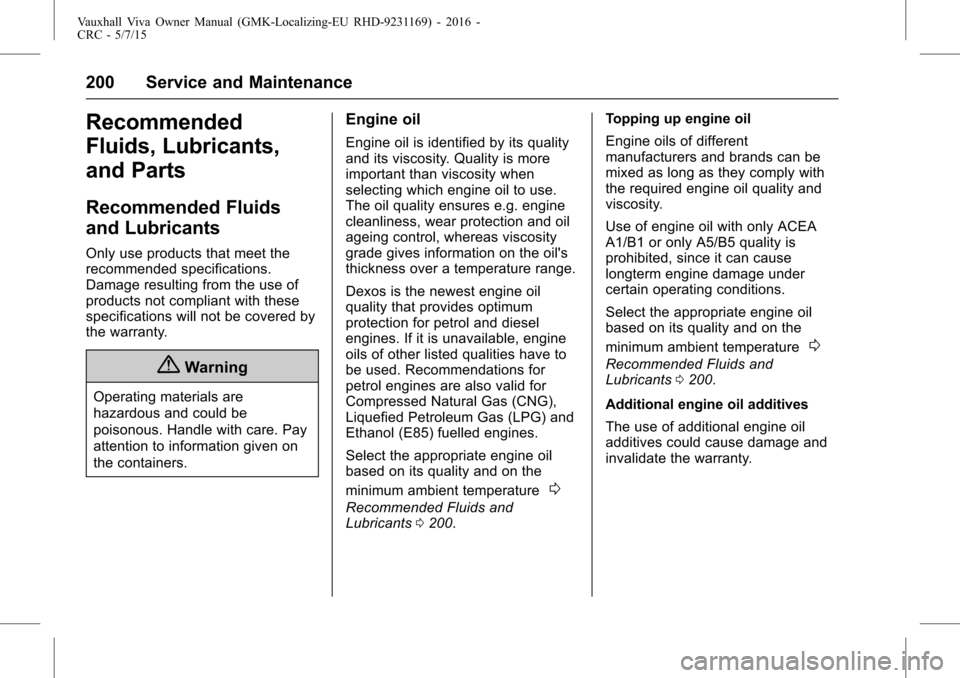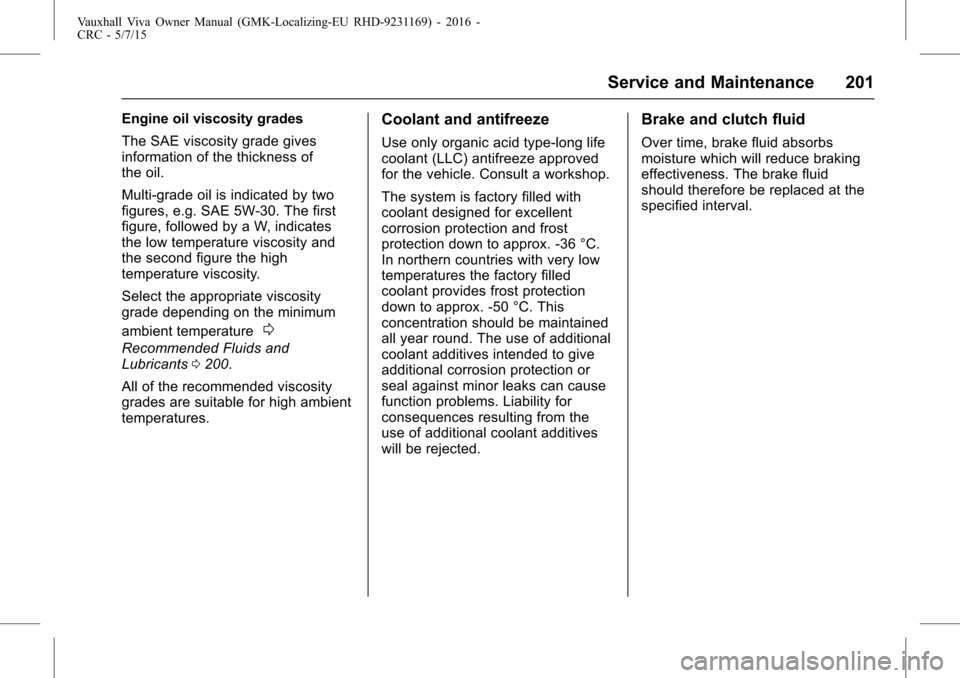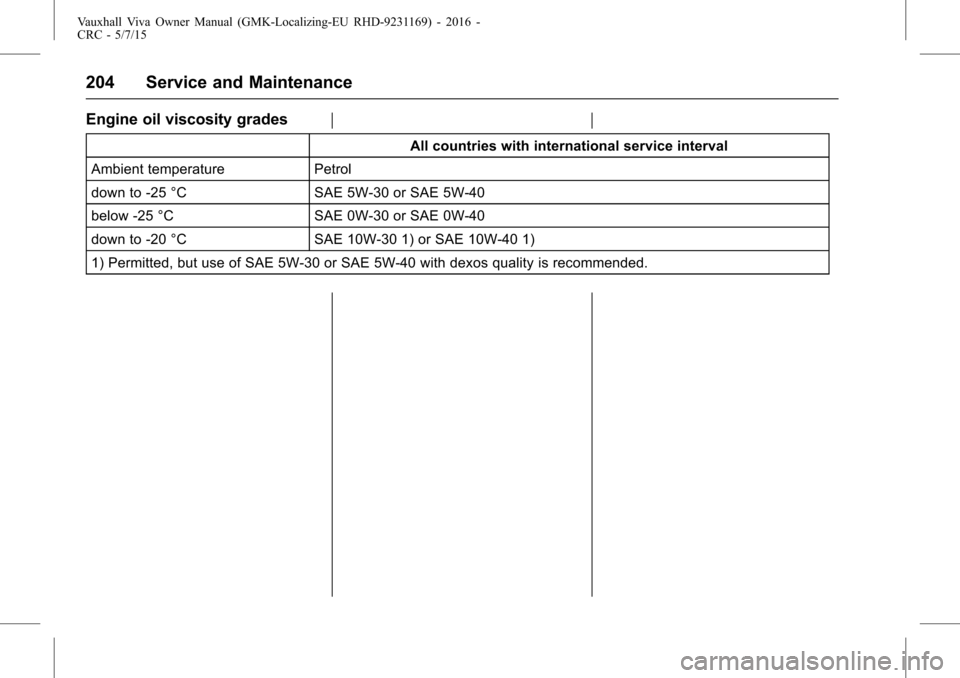2015.75 VAUXHALL VIVA temperature
[x] Cancel search: temperaturePage 182 of 222

Vauxhall Viva Owner Manual (GMK-Localizing-EU RHD-9231169) - 2016 -
CRC - 5/7/15
Vehicle Care 181
A detected low tyre pressure
condition is indicated by the control
indicator
70Tyre Pressure
Monitoring System Light 073.
If
7illuminates, stop as soon as
possible and inflate the tyres as
recommended
0Tyre
Pressure 0209.
If
7flashes for 60-90 seconds and
then illuminates continuously, there
is a fault in the system. Consult a
workshop. After inflating, driving may be
required to update the tyre pressure
values in the DIC. During this time
7may illuminate.
If
7illuminates at lower
temperatures and extinguishes after
some driving, this could be an
indicator for getting low pressure.
Check tyre pressure.
Vehicle messages
0Vehicle
Messages 080.
If the tyre pressure shall be reduced
or increased, switch off ignition.
Only mount wheels with pressure
sensors, otherwise the tyre pressure
will not be displayed and
7
illuminates continuously.
A temporary spare wheel is not
equipped with pressure sensors.
The tyre pressure monitoring
system is not operational for these
wheels. Control indicator
7
illuminates. For the further three
wheels the system remains
operational. The use of commercially available
liquid tyre repair kits can impair the
function of the system. Factory
approved repair kits can be used.
External high-power radio
equipment could disrupt the tyre
pressure monitoring system.
Each time the tyres are replaced
tyre pressure monitoring system
sensors must be dismounted and
serviced. For the screwed sensor :
Replace valve core and sealing ring.
For clipped sensor : Replace
complete valve stem.
Vehicle loading status
Adjust tyre pressure to load
condition according to tyre
information label or tyre pressure
chart
0Tyre Pressure
0209, and
select the relevant setting in the
menu Tyre Load in the Driver
Information Centre, Vehicle
Information Menu
0Driver
Information Centre (DIC) 075.
This setting is the reference for the
tyre pressure warnings.
Page 184 of 222

Vauxhall Viva Owner Manual (GMK-Localizing-EU RHD-9231169) - 2016 -
CRC - 5/7/15
Vehicle Care 183
button to activate the TPMS
sensor. A horn chirp confirms
that the sensor identification
code has been matched to this
tyre and wheel position.
10. Proceed to the right side front tyre, and repeat the procedure
in Step 9.
11. Proceed to the right side rear tyre, and repeat the procedure
in Step 9.
12. Proceed to the left side rear tyre, and repeat the procedure
in Step 9. The horn sounds
twice to indicate the sensor
identification code has been
matched to the left side rear
tyre, and the TPMS sensor
matching process is no longer
active.
13. Turn off the ignition.
14. Set all four tyres to the recommended air pressure
level as indicated on the tyre
pressure label. 15. Ensure the tyre loading status
is set according selected
pressure
0Driver Information
Centre (DIC) 075.
Temperature dependency
The tyre pressure depends on the
temperature of the tyre. During
driving, tyre temperature and
pressure increase. Tyre pressure
values provided on the tyre
information label and tyre pressure
chart are valid for cold tyres, which
means at 20 °C. The pressure
increases by nearly 10 kPa for a 10
°C temperature increase. This must
be considered when warm tyres are
checked.
The tyre pressure value displayed in
the DIC shows the real tyre
pressure. A cooled down tyre will
show a decreased value, which
does not indicate an air leak.
Tread Depth
Check tread depth at regular
intervals. Tyres should be replaced for safety
reasons at a tread depth of 2-3 mm
(4 mm for winter tyres).
For safety reasons it is
recommended that the tread depth
of the tyres on one axle should not
vary by more than 2 mm.
The legally permissible minimum
tread depth (1.6 mm) has been
reached when the tread has worn
down as far as one of the tread
wear indicators (TWI). Their position
is indicated by markings on the
sidewall.
Page 194 of 222

Vauxhall Viva Owner Manual (GMK-Localizing-EU RHD-9231169) - 2016 -
CRC - 5/7/15
Vehicle Care 193
.A discharged battery can
already freeze at temperatures
of 0 °C.
Defrost the frozen battery before
connecting jump leads.
. Wear eye protection and
protective clothing when
handling a battery.
. Use a booster battery with the
same voltage (12 volts). Its
capacity (Ah) must not be much
less than that of the discharged
battery.
. Use jump leads with insulated
terminals and a cross section of
at least 16 mm² (25 mm² for
diesel).
. Do not disconnect the
discharged battery from the
vehicle.
. Switch off all unnecessary
electrical consumers.
. Do not lean over the battery
during jump starting.
. Do not allow the terminals of one
lead to touch those of the
other lead. .
The vehicles must not come into
contact with each other during
the jump starting process.
. Apply the parking brake, manual
gearbox in neutral, automatic
transmission in P.
. Open the positive terminal
protection caps of both vehicle
batteries.
Lead connection order :
1. Connect the red lead to the positive terminal of the booster
battery. 2. Connect the other end of the
red lead to the positive terminal
of the discharged battery.
3. Connect the black lead to the negative terminal of the
booster battery.
4. Connect the other end of the black lead to a vehicle
grounding point, such as the
engine block or an engine
mounting bolt. Connect as far
away from the discharged
battery as possible, however at
least 60 cm(24 inches).
Route the leads so that they cannot
catch on rotating parts in the engine
compartment.
To start the engine : 1. Start the engine of the vehicle providing the jump.
2. After 5 minutes, start the other engine. Start attempts should
be made for no longer than
15 seconds at an interval of
1 minute.
Page 201 of 222

Vauxhall Viva Owner Manual (GMK-Localizing-EU RHD-9231169) - 2016 -
CRC - 5/7/15
200 Service and Maintenance
Recommended
Fluids, Lubricants,
and Parts
Recommended Fluids
and Lubricants
Only use products that meet the
recommended specifications.
Damage resulting from the use of
products not compliant with these
specifications will not be covered by
the warranty.
{Warning
Operating materials are
hazardous and could be
poisonous. Handle with care. Pay
attention to information given on
the containers.
Engine oil
Engine oil is identified by its quality
and its viscosity. Quality is more
important than viscosity when
selecting which engine oil to use.
The oil quality ensures e.g. engine
cleanliness, wear protection and oil
ageing control, whereas viscosity
grade gives information on the oil's
thickness over a temperature range.
Dexos is the newest engine oil
quality that provides optimum
protection for petrol and diesel
engines. If it is unavailable, engine
oils of other listed qualities have to
be used. Recommendations for
petrol engines are also valid for
Compressed Natural Gas (CNG),
Liquefied Petroleum Gas (LPG) and
Ethanol (E85) fuelled engines.
Select the appropriate engine oil
based on its quality and on the
minimum ambient temperature
0
Recommended Fluids and
Lubricants0200. Topping up engine oil
Engine oils of different
manufacturers and brands can be
mixed as long as they comply with
the required engine oil quality and
viscosity.
Use of engine oil with only ACEA
A1/B1 or only A5/B5 quality is
prohibited, since it can cause
longterm engine damage under
certain operating conditions.
Select the appropriate engine oil
based on its quality and on the
minimum ambient temperature
0
Recommended Fluids and
Lubricants
0200.
Additional engine oil additives
The use of additional engine oil
additives could cause damage and
invalidate the warranty.
Page 202 of 222

Vauxhall Viva Owner Manual (GMK-Localizing-EU RHD-9231169) - 2016 -
CRC - 5/7/15
Service and Maintenance 201
Engine oil viscosity grades
The SAE viscosity grade gives
information of the thickness of
the oil.
Multi-grade oil is indicated by two
figures, e.g. SAE 5W-30. The first
figure, followed by a W, indicates
the low temperature viscosity and
the second figure the high
temperature viscosity.
Select the appropriate viscosity
grade depending on the minimum
ambient temperature
0
Recommended Fluids and
Lubricants0200.
All of the recommended viscosity
grades are suitable for high ambient
temperatures.
Coolant and antifreeze
Use only organic acid type-long life
coolant (LLC) antifreeze approved
for the vehicle. Consult a workshop.
The system is factory filled with
coolant designed for excellent
corrosion protection and frost
protection down to approx. -36 °C.
In northern countries with very low
temperatures the factory filled
coolant provides frost protection
down to approx. -50 °C. This
concentration should be maintained
all year round. The use of additional
coolant additives intended to give
additional corrosion protection or
seal against minor leaks can cause
function problems. Liability for
consequences resulting from the
use of additional coolant additives
will be rejected.
Brake and clutch fluid
Over time, brake fluid absorbs
moisture which will reduce braking
effectiveness. The brake fluid
should therefore be replaced at the
specified interval.
Page 203 of 222

Vauxhall Viva Owner Manual (GMK-Localizing-EU RHD-9231169) - 2016 -
CRC - 5/7/15
202 Service and Maintenance
European service schedule
Required engine oil qualityAll European countries with European service interval
Engine oil quality Petrol engines (including CNG, LPG, E85)
dexos 1
dexos 2
V
In case dexos quality is unavailable you may use max. 1 litre engine oil quality ACEA C3 for topping up once between
each oil change.
Engine oil viscosity grades
All European countries with European service interval
Ambient temperature Petrol
down to -25 °C SAE 5W-30 or SAE 5W-40
below -25 °C SAE 0W-30 or SAE 0W-40
Page 205 of 222

Vauxhall Viva Owner Manual (GMK-Localizing-EU RHD-9231169) - 2016 -
CRC - 5/7/15
204 Service and Maintenance
Engine oil viscosity grades
All countries with international service interval
Ambient temperature Petrol
down to -25 °C SAE 5W-30 or SAE 5W-40
below -25 °C SAE 0W-30 or SAE 0W-40
down to -20 °C SAE 10W-30 1) or SAE 10W-40 1)
1) Permitted, but use of SAE 5W-30 or SAE 5W-40 with dexos quality is recommended.
Page 212 of 222

Vauxhall Viva Owner Manual (GMK-Localizing-EU RHD-9231169) - 2016 -
CRC - 5/7/15
Customer Information 211
Vehicle Data
Recording and
Privacy
Event Data Recorders
Data storage modules in the
vehicle
A large number of electronic
components of your vehicle contain
data storage modules temporarily or
permanently storing technical data
about the condition of the vehicle,
events and errors. In general, this
technical information documents the
condition of parts, modules, systems
or the environment:
.Operating conditions of system
components (e.g. filling levels)
. Status messages of the vehicle
and its single components (e.g.
number of wheel revolutions /
rotational speed, deceleration,
lateral acceleration) .
Dysfunctions and defects in
important system components
. Vehicle reactions in particular
driving situations (e.g. inflation of
an airbag, activation of the
stability regulation system)
. Environmental conditions (e.g.
temperature)
This data is exclusively technical
and helps identify and correct errors
as well as optimise vehicle
functions.
Motion profiles indicating travelled
routes cannot be created with
these data.
If services are used (e.g. repair
works, service processes, warranty
cases, quality assurance),
employees of the service network
(manufacturer included) are able to
read out this technical information
from the event and error data
storage modules applying special
diagnostic devices. If required, you
will receive further information at
these workshops. After an error has been corrected, the data is deleted
from the error storage module or
constantly overwritten.
When using the vehicle, situations
may occur in which these technical
data related to other information
(accident report, damages on the
vehicle, witness statements etc.)
may be associated with a specific
person - possibly, with the
assistance of an expert.
Additional functions contractually
agreed upon with the client (e.g.
vehicle location in emergency
cases) allow the transmission of
particular vehicle data from the
vehicle.